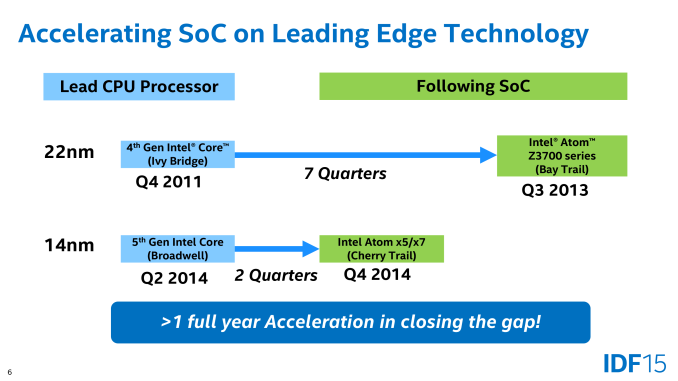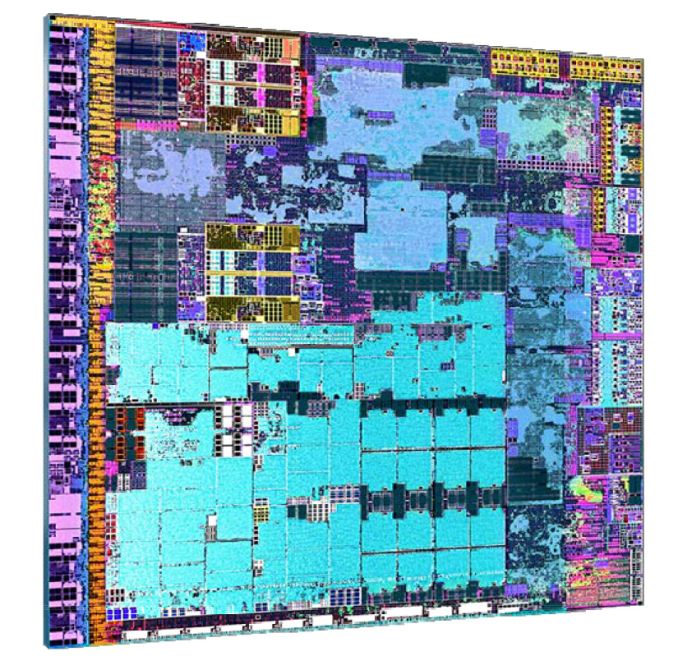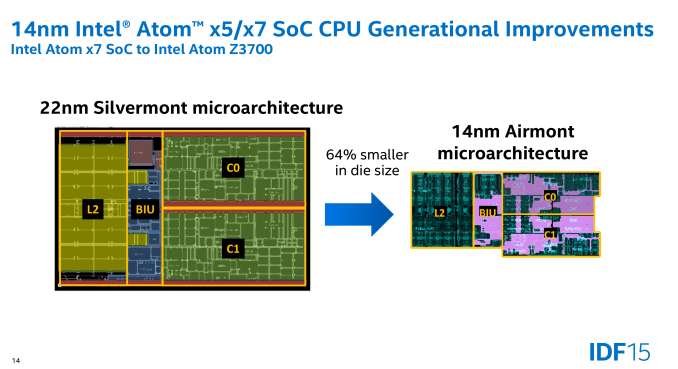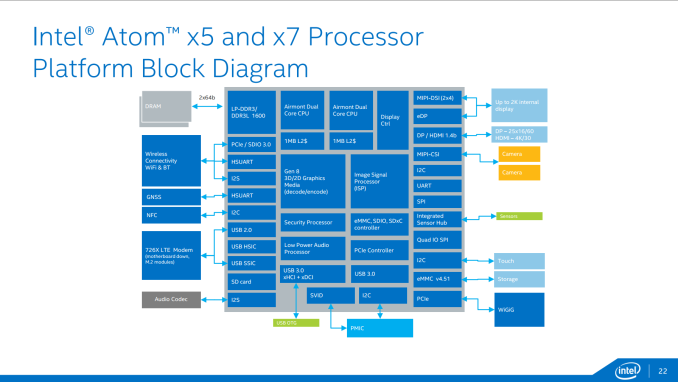The Surface 3 Review
by Brett Howse on May 4, 2015 9:00 AM ESTPowering the Surface 3: Intel’s Atom x7 System on a Chip
I still remember when back in 2011 Intel announced that they were finally going to stop treating Atom as a second class citizen at the manufacturing level, and bring it in line with the company’s mainstream Core processors. After having drawn out the 45nm and 32nm Atoms for too long, and suffering in the marketplace versus ARM as a result – Intel realized that to combat the growing threat of ARM they would need to treat the mobile market more seriously, and they would need to commit their sizable manufacturing advantage to the field to do this.
Now even Intel can’t turn on a dime – processors design begins half a decade in advance these days – so what have seen is a gradual ramping up towards this point. Silvermont, Intel’s first 22nm Atom, would introduce a more modern and better performing out-of-order architecture for Atom, meanwhile Intel would catch up on the manufacturing side by not producing 2 generations of Atoms on the 22nm node. Instead Silvermont would be the only 22nm Atom, and was to be followed by 14nm Airmont roughly a year later.
With Intel’s initial 14nm problems that year later ended up being a bit longer than a year, but in 2015 we’re finally there, and the change is remarkable. Only one generation ago, Intel launched their 22nm process as they always do, with desktop and high-performance laptop processors first. Now with 14nm the tables have been turned; Atom didn’t get first-dibs on 14nm – that went to Core M – but Airmont is still going to beat Intel’s desktop and high-performance Broadwell SKUs to the retail market. In one generation Intel has gone from favoring the desktop to favoring mobile, that’s how serious Intel has become.
That brings us to Surface 3, and the SoC powering it: Cherry Trail. The successor to the Silvermont-based Bay Trail that has powered so many x86 tablets in the last year, Cherry Trail is a distinct tick in Intel's tick-tock cadence. What this means is that Intel has largely retained the same architecture as in Bay Trail, investing in a fairly small number of updates, looking to take advantage of the power consumption and die size (cost) benefits of 14nm. To that end Intel has not even bothered to announce any major architectural changes for Airmont, and while there will likely be a few tweaks made to the CPU to make it work more efficiently on 14 nm, we will have to wait for Goldmont for the next big Atom architecture.
Cherry Trail itself is a fairly small chip. While Intel hasn’t released an official die size for it (no more than they did Bay Trail), from various IDF presentations they have released official numbers for the complete package, and decent photos as well. As a result we can take a decent stab at die sizes, and from Intel’s photos we’d estimate that the die size is around 83mm2. Unfortunately we don’t have anything quite comparable to Bay Trail, though we believe it to be a good bit smaller than Intel’s previous generation tablet SoC. At 83mm2 this would put the die size at quite a bit smaller than Apple’s A8X tablet SoC, and actually is just a hair smaller than the A8 phone SoC’s 89mm2.
Diving a bit deeper, Intel has also released some size data for individual Silvermont/Airmont CPU modules. The dual core modules, which contain the 2 CPU cores along with L2 cache and appropriate glue, have shrunk significantly from Silvermont to Airmont. Overall the Airmont CPU module is 64% smaller than the Silvermont module. And to be clear that does not mean Airmont is 64% of the size of Silvermont, that means that Airmont has been reduced by 64%; relative to Silvermont it is only 36% of the die size. Intel has achieved a better scaling factor than 22nm to 14nm alone, indicating that they have almost certainly enacted further optimizations to bring down the die size as an architectural level.
Moving on to the architecture of Cherry Trail, each Airmont core is a two-wide instruction decode with out of order execution. The L1 cache is 32 KB 8-way associative for instructions, and 24 KB 6-way associative data cache. Level 2 cache is 16-way associative with 1 MB of cache shared between two cores. There will be either two or four core versions available, which means that each SoC will have between 1 and 2 MB of L2 cache depending on the number of cores. There is no L3 cache on Atom.
The System on a Chip (SoC) has support for LP-DDR3 or DDR3L 1600 in dual-channel configuration, and has the blocks needed for PCIe 3.0, USB 2.0, USB 3.0, and support for up to three displays with eDP, DP, and HDMI 1.4b. The built in storage support is eMMC v4.5.1, which is typical for a tablet class processor.
Here is a Block Diagram of the SoC.
The one truely major change to the SoC is the inclusion of Intel's Gen 8 Graphics. Bay Trail used Gen 7 Graphics from Ivy Bridge, and Bay Trail only had 4 Execution Units (EUs) available. Cherry Trail ramps that up significantly, with the latest Gen 8 Graphics from Broadwell now onboard, bringing forward Intel's GPU enhancements over the last two half generations, not to mention the compute enhancements as well.
In terms of execution hardware the x7-8700 model has 16 EUs available, indicating that Intel has spent a significant amount of their die size savings from the 14nm process on graphics resources. Gen 8 has eight EUs per sub-slice but a minimum of three sub-slices in the design, and therefore in order to improve SoC yields the thread scheduler will dynamically allocate the right amount of cores per-subslice to total 16. For comparison, Intel's Broadwell line of Core processors have a minimum of 23 (but most have 24) EUs available, and a maximum of 48, so with Cherry Trail Intel has closed the top-to-top gap in execution resources between Core and Atom to just 3-1.
In Intel’s datasheets, the Atom GPU is labeled as Gen8-LP to designate that this is a low power model being used in a tablet. The base frequency for this GPU is 200 MHz, with a boost of 600 MHz.
In addition to the GPU update, the ISP and hardware decode capabilities get a bump as well. There is full hardware acceleration for decode of H.263, MPEG4, H.264, H.265 (HEVC), VP8, VP9, MVC, MPEG2, VC1, and JPEG, as well as hardware encode for H.264, H.263, VP8, MVC, and JPEG. This marks the first Intel product to ship with the company's full, fixed-function HEVC decoder, making Atom the company's most advanced media processor, at least for this short moment.
The overall SoC is 17mm x 17mm, and the Z-height is 0.937mm, so it is quite a bit smaller than Core M’s 30mm x 16.5mm x 1.05mm package. Intel is not listing a Thermal Design Power for the Atom chip, but is instead listing it as a Scenario Design Power of 2 watts. The CPU base frequency is 1.6 GHz with a turbo frequency of 2.4 GHz, and there is also support for a Low Frequency Mode of just 480 MHz for extra power savings when needed.
| Atom x7-8700 | Atom Z3785 | |
| Architecture | Cherry Trail (Airmont) | Bay Trail (Silvermont) |
| Cores / Threads | 4 / 4 | 4 / 4 |
| Base Frequency (MHz) | 1.6GHz | 1.5GHz |
| Turbo / Burst (MHz) | 2.4GHz | 2.4GHz |
| L2 Cache | 2 MB | 2 MB |
| SDP | 2 W | 2.2 W |
| GPU Architecture | Gen 8 | Gen 7 |
| GPU Execution Units | 16 | 4 |
| GPU Frequency / MHz | 200-600MHz | 313-833Mhz |
| DRAM | LPDDR3-1600 | LPDDR3-1333 |
So what we really have here is a massaged Bay Trail class chip, but the 14 nm process should allow for a higher period of sustained turbo frequencies to help out with performance. It will be interesting to see what Intel does with Goldmont, and if they will add things like hyper-threading or not, but that discussion is for another time.
















265 Comments
View All Comments
MrSpadge - Monday, May 4, 2015 - link
Using legacy apps (which are still called programs) should be fine with the pen. Except for the high DPI display - depending on how legacy the app exactly is.Alexvrb - Monday, May 4, 2015 - link
It runs touch-friendly modern apps (including Universal apps which will be getting a boost in the near future) as well as more traditional software. You can use just about any external accessory that you can with a regular PC. If you use the dock and a larger monitor this can even replace the desktop for many users. In many ways it is more versatile than the devices you mentioned.stephenbrooks - Saturday, May 9, 2015 - link
Actually a lot of programs designed for mouse input (click and drag) work pretty well on a touchscreen Windows machine. The main problem is the buttons tend to be too small for fingers.It would be great if Microsoft could have an option to magically enlarge GUI elements a bit when in touch mode.
jaydee - Monday, May 4, 2015 - link
When I say lack of apps, I mean as designed as portable tablet. That's what MS is touting, it's a tablet and laptop in one.Of course it has tons of apps as a Win8/10 device, but if that's all you're really after, why buy something that straddles the line between laptop and tablet? Why not an XPS 13 or Spectre x360? Proportionally few of those Windows apps tend to run real well on a 10" touch screen with a resolution of 1920x1280.
It just seems to be in an odd place. I'm not sure what it does really well, other than its display. CPU/RAM/SSD are all compromised as a laptop and it's too expensive for what it does as a tablet. It's not "bad" by any means, I really do *want* to like it, it just doesn't seem to do the laptop thing well enough, be a tablet at a low enough price point. And I'm someone who would like to replace my iPad Air with something convertible like this. But if I'm going to buy a laptop that can also be used as a tablet, it's either going to have to have higher performance, or be cheap enough to not feel bad replacing in a couple years, and I don't feel either with this (particularly with accessories). I'm much more apt to get the i5/8GB/256GB HP Spectre x360 @$1,000, while more expensive, I feel much better about thinking about using for the next 5 years, compared to the Surface $600 + type cover + dock @ $930 and still has a tablet mode. The Surface Pro 3 is nice, but I'm not sure what it offers over the Spectre x360, at a sales price of ~$1,130 (retail $1,300), not to mention being a gen behind with Haswell still. If history is any indication, I will like the SP4 as a product, but probably not at it's price point.
Impulses - Monday, May 4, 2015 - link
If the base model included 4GB and/or they at least threw in the pen for free with certain combos, it'd be more enticing. It's still an attractive package for people who just want a secondary system, but a lot of those are just gonna end up with cheaper tablets or more capable laptops.Even tho it's significantly cheaper than SP3, and it's exactly what a lot of people said the base Surface should've been all along, it still feels like less of a value proposition than SP3. Better storage and Type C might've made it more appealing...
As it is it feels too much like something they'll refine significantly for the next rev... Big EDU discounts could sway things tho. A simple $100 student discount would make it a $530-630 hybrid competing against $400-500 tablets and $750+ laptops, much better sweet spot.
simard57 - Thursday, May 7, 2015 - link
Costco has a bundle that includes keyboard and pen for $100 more over the 2GB and 4GB modelsillegaloperation - Monday, May 4, 2015 - link
How much is portability worth to you?The HP Spectre x360 weigh over twice that of the Surface 3.
Also, why is the Dock being factor into the price? The Dock is nice to have, but it's hardly essential.
The0ne - Monday, May 4, 2015 - link
Just curious, what apps are you missing one the Windows platform? For someone like me who would use this for work, I can't imagine an app that is not available that I would use. You mean it doesn't have the hundreds and thousands of useless apps that are in all markets? Always confused by this statement.jaydee - Tuesday, May 5, 2015 - link
In order for it to be considered a good "tablet", it has to do all those things that tablets are known for. Apple and Android have this tremendously large ecosystem that many people are vested in and there's a huge selection for. Obviously "entertainment" apps are going to be useless for people who use this for work. Just like the "productivity" apps aren't useful for those who use it for entertainment, etc. Certainly, the Windows tablet is a better match for a certain type of productivity user like yourself, then a gamer per se. What a tablet has come to be, for many people though is a ubiquitous device that transcends both genres and I don't see that in the Windows platform. Not to mention the fact that Apple/Android tablet users are going to have a hard time switching over if they've invested a decent amount of money into their Apple/Android apps.Like I said, I really want to like this device, but it just feels like too many compromises as a laptop and a mixed bag as a tablet. Does that mean that it's not a great device for some people? Absolutely not! I just don't see it doing one (laptop) or the other (tablet) well enough to break through mainstream and be a big seller at this price point. As other people have mentioned, if it were a lower price or included accessories or faster storage or Core-M instead of Atom were here, I would probably feel much different, but it's too many compromises as is.
Gigaplex - Monday, May 4, 2015 - link
With Windows 10, Microsoft is aiming to bridge the "App gap" by making porting of iOS and Android apps to Windows fairly trivial.